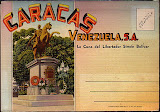"Macuto. Hotel Miramar" (Photo Postcard - Archivo Fundación de la Memoria Urbana)
Apreciado don Arístides,
De nuevo, el Miramar. Pero, fíjese, por favor, aparte de toda la belleza de esta Post Card fotográfica -y quizás por ella-, en la caligrafía meticulosa de quien la adquiriera un día para jamás enviarla...
"MACUTO": nombre de palacio.Y nombre de ciudad. Por arte de magia, Roma y Caracas se unen en una sola y palaciega palabra. De aquel Palazzo Macuto que se levanta...
Cordialmente,
De nuevo, el Miramar. Pero, fíjese, por favor, aparte de toda la belleza de esta Post Card fotográfica -y quizás por ella-, en la caligrafía meticulosa de quien la adquiriera un día para jamás enviarla...
"MACUTO": nombre de palacio.Y nombre de ciudad. Por arte de magia, Roma y Caracas se unen en una sola y palaciega palabra. De aquel Palazzo Macuto que se levanta...
Cordialmente,
señora Gómez
(Photo Postcard - Archivo Fundación de la Memoria Urbana)
Cordialmente,
señora Gómez
Listen to La Colonna Musicale
-Ottorino Respighi (1879-1936). Sonata per pianoforte in fa minore (P.16) (1897).
-Ottorino Respighi (1879-1936). Sonata per pianoforte in fa minore (P.16) (1897).
Dear don Arístides,
Again, the Miramar. But please note, apart from the beauty of this Photo Post Card -and perhaps because of it-, the meticulous handwriting of who acquired it one day to never sent it...
"MACUTO": a palace's name. And a town's name. Magically, Rome and Caracas are united in a single palatial word. From that Palazzo Macuto that rises in...
Again, the Miramar. But please note, apart from the beauty of this Photo Post Card -and perhaps because of it-, the meticulous handwriting of who acquired it one day to never sent it...
"MACUTO": a palace's name. And a town's name. Magically, Rome and Caracas are united in a single palatial word. From that Palazzo Macuto that rises in...
Cordially yours,
señora Gómez



























